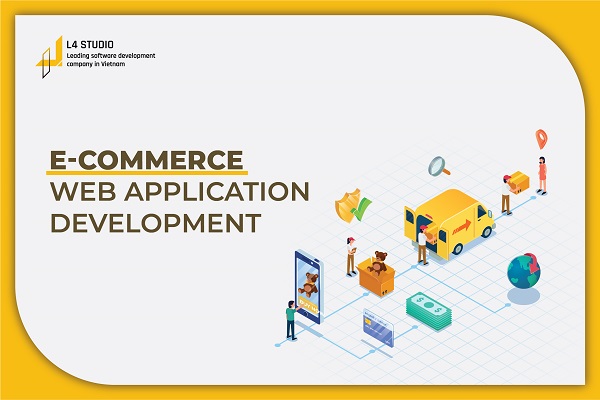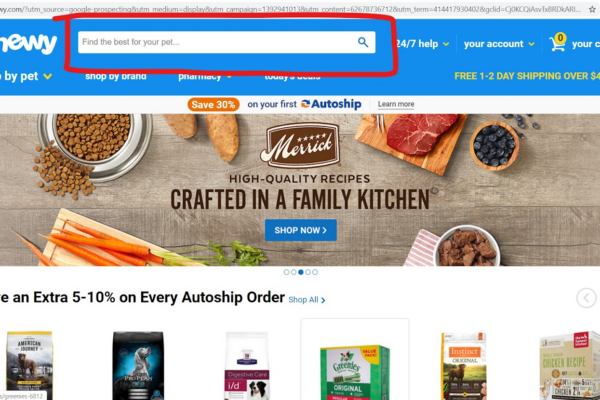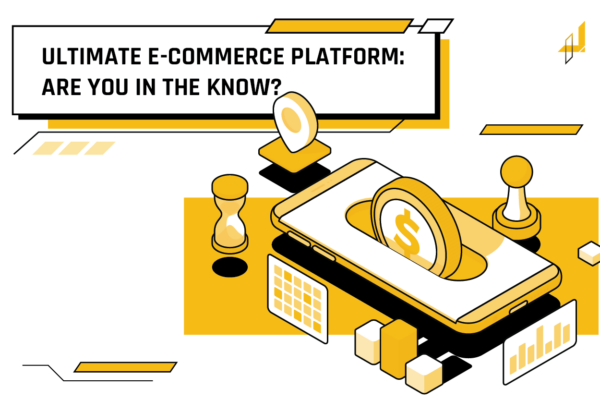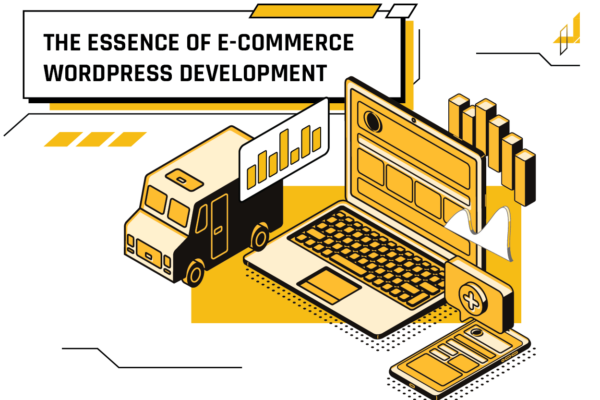
E-COMMERCE WEB APPLICATION DEVELOPMENT
Making your e-commerce site well-built and entirely standardized for a more excellent client experience is vital. To compete with e-commerce, you get to make your site alive by implementing the modern design or promoting of newest and store version. In this post, let’s learn more about e-commerce web application development in Ho Chi Minh.
Overview of an e-commerce web application
The globe of e-commerce is rapidly developing. On the other hand, it is hard to envision a continent without e-commerce in which one might buy anything at the moment and from any zone. Shopping on those e-commerce sites is as simple as strolling around the park. Individuals just move to their online shop’s site or mobile application, make a wishlist, and put in their last order.
A good e-commerce web application development is more than just attractive on the surface. If carried out correctly, it will result in actual sales and profits for your small business by optimizing the consumer ordering procedure and creating brand equity that can sustain your enterprise.

Figure 1. E-commerce web app development
Typical examples of web applications
The process of carrying out the construction plan for the front end and back end of your e-commerce website is known as e-commerce web application development. Your product pages, shopping cart, order form, and support pages are all included in this.
PWAs (Progressive web applications) are becoming an essential priority for e-commerce companies through the upcoming year, as client expectations are high. Next, PWAs commit to providing the top speed and increased experience of the native application to mobile browsers, which is to be expected provided that they are the subsequent development in front-end web tech.
When it comes to stores that have precisely grabbed this cutting-edge tech, it has led to right away improved efficiency, better client interaction, and boosted mobile conversion. In addition to that, PWA is making more norms for online interaction best practices, between client-friendliness to nonpareil load speed.
WHAT GOES INTO DEVELOPMENT AN E-COMMERCE WEB APPLICATION?
A good e-commerce web application development process includes a number of processes with varied degrees of complexity, from developing the site’s architecture to defining your business’s brand online.
1. CREATE YOUR BRAND
Making decisions is necessary for brand building in an e-commerce setting. Are you running a business-to-business (B2B) or business-to-consumer (B2C) app, first of all? Every e-commerce project should be customized to your target audience’s wants and preferences, from the picture style to the degree of information in the product descriptions. Next, you should think of a catchy company name that people will remember.
2. INVEST IN A DOMAIN NAME
While deciding on a name for your e-commerce company, you might also want to take domain name availability into account. Although purchasing a name is simple, popular domains occasionally sell out quickly. If the domain you want is still available, attempt to secure it as soon as you can (you may choose a short-term contract of a year or two in case you’re not entirely committed). You might want to look to see what Domains are available before deciding on a company name in order to improve brand awareness and generate traffic to your e-commerce site.
3. CHOOSE A HOSTING SYSTEM
After acquiring your domain, you may launch your website by selecting a web host (ideally one that has an e-commerce platform) to host it. Others provide pre-built website designs that are suitable for both desktop and mobile viewing, while some hosting services are more basic and need you to design and develop the website yourself.
4. CREATE YOUR WEB APPLICATION
Beyond a recognizable logo and striking color scheme, your website design should clearly convey the objectives of your company. Due to the fact that this is the primary operation of your e-commerce website, take great care while building an intuitive online shop with simple search and filtering options. Sales might be lost and a brand’s reputation can suffer as a result of a disorganized website design or a difficult checkout process.
5. CREATE AND PUBLISH YOUR WEBSITE
Using a platform like Shopify to create your own website using a prefab approach—dropping pre-coded content blocks and picture placeholders into a site-building interface—could help you save money on e-commerce web application development expenditures. If you have a little more money to spend, you can still design your website individually with a developer, then move the site over using a hosting platform like Shopify.
6. ESTABLISH THE ORDER FULFILLMENT PROCESS
Which method of e-commerce fulfillment will you choose? Dropshipping (buying products directly from suppliers on behalf of clients), in-house fulfillment, or third-party logistics (completely outsourcing fulfillment processing)? This will influence your site’s look and your ability to accept orders. Make sure your ad content sufficiently informs clients of when they may expect to get their package, for example, if you depend on a third-party logistics firm and they have a normal delivery time range.
7. MAINTENANCE OF YOUR WEBSITE
To reflect changes in your inventory, product line, and any ongoing specials, your e-commerce website will need to be updated on a frequent basis. You could discover that some elements of your website’s design need to be changed as a result of user feedback or that it lacks functionality that you or your clients want. Ecommerce websites, in contrast to physical stores, may be modified with the click of a button.
Simple tips for developing the e-commerce website
Each successful e-commerce web application development has to include a number of essential components, including secure back-end code, clickable features, and an efficient checkout process.
1. EXCELLENT UI/UX
A good user interface (UI) and user experience (UX) design will be present on a successful e-commerce website. Filters that enable buyers to quickly identify their chosen product or range of items, a search bar, a clean design, and clear copy are fundamental components of effective UI/UX in an ecommerce setting.
2. Product bar can be attractive
Clients might take a chance to witness a wide range of products. A great designer might display the products through the bar as shown by available sales in the e-commerce site market. They have to understand persons’ requests and link to them when they dismiss the thing to purchase.

Figure 2. The product bar needs to be attractive
3. Quick page loading with simple navigation
The web app might load pages right away during clients’ move on the website. Now, when the client needs to discover the home page of your site during finding out about the internal pages; it might drive the visitor idler and get off from the website.
4. Genuine product images
The product images can be genuine and seem attractive to site customers. Next, designing is the solution to stimulate people to purchase your products on the e-commerce platform. The promising customer purchases items from the e-commerce business web app just while they look for images of the genuine versions.
5. DEPENDABLE INTERNET SAFETY
Your online store’s security, as well as the protection of any data it processes or maintains, must be top priority. You are in charge of handling the private financial data of your clients, such as their credit card numbers and postal addresses. Using “transport layer security” (TLS), “secure sockets layers” (SSL), and HTTPS authentication—programs that authenticate and encrypt links between consumer computers and your site—are among the best practices for ecommerce customer security. Don’t use easy-to-guess passwords. Also, you may make sure that antivirus and anti-malware software is installed on all company-owned devices.
6. Specialize in shopping cart
The shopping cart might show the chosen thing all the time. This might make the purchase simpler for customers. When clients are surfing and shopping on the e-commerce site, it is vital to hold them by announcing how many goods are in their shopping cart and what these things are.
On top of it, individuals will analyze what kind of items they have selected and what their expenses are. The extra charges after shopping from e-commerce websites might keep clients away from arriving again your store.
7. FLUID CHECKOUT PROCESS
Sales might be lost as a result of a difficult checkout process. Customers may decide not to make a purchase at all if they are required to go through protracted, difficult sign-up procedures. Think about introducing a guest checkout option that enables users to make purchases with little interaction from them (and less data). Instead of using the standard filled shopping cart option, you may think about introducing a one-click checkout tool for clients who have previously joined up with your site and whose credit card information is saved with you (securely!). Moreover, you can incorporate third-party payment methods like Shop Pay and Apple Pay, as well as enable users to join up fast by connecting their Facebook or Google accounts.
Closing Ideas
E-commerce web application development in Ho Chi Minh is becoming all the rage with all users. After scanning this post, you can gain a deeper insight into the overall picture of web app development.
Sources: Internet
——————————
L4 STUDIO – LEADING SOFTWARE DEVELOPMENT COMPANY IN VIETNAM
Website: https://l4studio.net/
Email: hi@l4studio.net
Phone: (+84) 28 6675 6685
Our Ecommerce Software Development Services: https://l4studio.net/ecommerce-development-services/
For more interesting blogs: https://l4studio.net/it-knowledge/
Follow us at: https://www.facebook.com/L4Studiovn/
Read more: CUSTOM E-COMMERCE SOFTWARE DEVELOPMENT COMPANY – EVERYTHING YOU NEED TO DISCOVER








